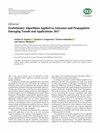为无人机辅助网络构建体积无线电环境地图的深度学习方法
IF 1.1
4区 计算机科学
Q4 ENGINEERING, ELECTRICAL & ELECTRONIC
引用次数: 0
摘要
为无所不在的用户提供全球覆盖是第五代(5G)及以后无线技术的关键要求。这可以通过将无人机(UAV)和卫星网络等机载网络与地面网络进行整合来实现。然而,在三维(3D)或体积空间部署机载网络需要对传播信道及其在面积和高度维度上的损耗有新的认识。尽管对无线电环境图(REM)构建进行了大量研究,但大部分研究仅限于二维(2D)环境。这忽视了电磁波传播的高度相关特性,并将 REM 限制为二维格式,从而限制了空间维度传播环境变化的全面和连续可视化。本文提出了一种体积 REM(VREM)构建方法来计算三维传播损耗。该方法通过学习无线传播信道特征的空间相关性,并利用深度学习模型在面积和高度/海拔维度可视化 REM,解决了现有方法的局限性。具体来说,该方法使用了两种基于深度学习的模型:带有三维生成对抗网络的体积对体积(Vol2Vol)VREM 和带有高度感知蜘蛛网的切片 VREM。在这两种情况下,三维空间中的传播环境和发射机位置知识都被用来捕捉传播信道特性的空间和高度依赖性。我们开发了 Addis 数据集,这是一个大型 REM 数据集,包含从埃塞俄比亚亚的斯亚贝巴市区采集的 54,000 个样本,用于训练所提出的模型。每个数据样本包括一个 512 米乘 512 米的区域分辨率、不同的三维障碍物(建筑物和地形)、15 张每 3 米高度分辨率的模拟传播损耗图以及 80 个不同的三维发射机位置。拟议模型的训练和测试结果表明,所构建的 VREM 在统计上具有可比性。其中,Vol2Vol 方法的最小 L1 损失为 0.01,当视距(LoS)概率增加到 0.95 时,L1 损失进一步减少到 0.0084。本文章由计算机程序翻译,如有差异,请以英文原文为准。
A Deep-Learning Approach to a Volumetric Radio Environment Map Construction for UAV-Assisted Networks
Providing global coverage for ubiquitous users is a key requirement of the fifth generation (5G) and beyond wireless technologies. This can be achieved by integrating airborne networks, such as unmanned aerial vehicles (UAVs) and satellite networks, with terrestrial networks. However, the deployment of airborne networks in a three-dimensional (3D) or volumetric space requires a new understanding of the propagation channel and its losses in both the areal and altitude dimensions. Despite significant research on radio environment map (REM) construction, much of it has been limited to two-dimensional (2D) contexts. This neglects the altitude-related characteristics of electromagnetic wave propagation and confines REMs to 2D formats, which limits the comprehensive and continuous visualization of propagation environment variation in spatial dimensions. This paper proposes a volumetric REM (VREM) construction approach to compute 3D propagation losses. The proposed approach addresses the limitations of existing approaches by learning the spatial correlation of wireless propagation channel characteristics and visualizing REM in areal and height/altitude dimensions using deep learning models. Specifically, the approach uses two deep learning-based models: volume-to-volume (Vol2Vol) VREM with 3D-generative adversarial networks and sliced VREM with altitude-aware spider-UNets. In both cases, knowledge of the propagation environment and transmitter locations in 3D space is used to capture the spatial and altitude dependency of the propagation channel’s characteristics. We developed the Addis dataset, a large REM dataset comprising 54,000 samples collected from the urban part of Addis Ababa, Ethiopia, to train the proposed models. Each sample of data comprises a 512-meter by 512-meter areal resolution with different 3D obstacles (buildings and terrain), 15 simulated propagation loss maps at every 3-meter altitude resolution, and 80 different 3D transmitter locations. The results of the training and testing of the proposed models reveal that the constructed VREMs are statistically comparable. In particular, the Vol2Vol approach has a minimum L1 loss of 0.01, which further decreases to 0.0084 as the line-of-sight (LoS) probability increases to 0.95.
求助全文
通过发布文献求助,成功后即可免费获取论文全文。
去求助
来源期刊

International Journal of Antennas and Propagation
ENGINEERING, ELECTRICAL & ELECTRONIC-TELECOMMUNICATIONS
CiteScore
3.10
自引率
13.30%
发文量
158
审稿时长
3.8 months
期刊介绍:
International Journal of Antennas and Propagation publishes papers on the design, analysis, and applications of antennas, along with theoretical and practical studies relating the propagation of electromagnetic waves at all relevant frequencies, through space, air, and other media.
As well as original research, the International Journal of Antennas and Propagation also publishes focused review articles that examine the state of the art, identify emerging trends, and suggest future directions for developing fields.
 求助内容:
求助内容: 应助结果提醒方式:
应助结果提醒方式:


